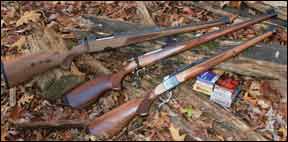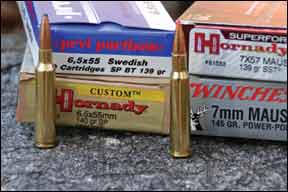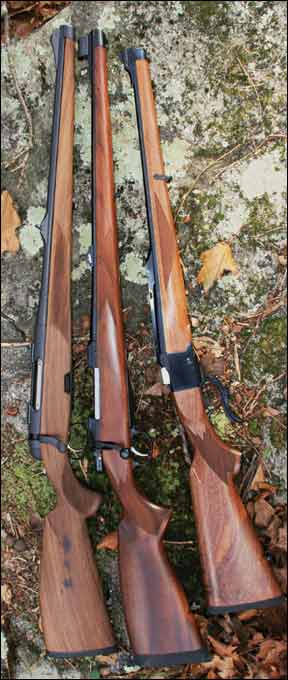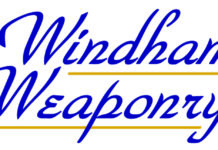The full-length stocks of Mannlicher-style rifles make them distinct, evoking the aesthetics of one of the most iconic rifles ever manufactured. In 1903 the military rifle company of Mannlicher-Schonauer introduced a sporter rifle. This Austrian-made Mannlicher sporter became the stuff of legends and would be used on all types of game from African savannas and the mountain ranges of Europe to here in the U.S. They were fast-handling carbines that offered a silky smooth bolt-action and packed a punch. Ernest Hemingway owned and wrote about the “little Mannlicher,” and W.D.M. “Karamojo” Bell used one exclusively on elephant. These short rifles had characteristics unlike other bolt-actions then or now. Along with the full-length stock that ran to the barrel muzzle, originals had a split bridge action. Since the bolt handle was positioned forward of the trigger assembly, unlike most bolt actions where the bolt handle is aft of the trigger, the bolt needed to pass through the bridge to cycle. The Mannlicher-Schonauer is also known for its fixed rotary magazine, set triggers and a flat, butter knife bolt handle.

We wanted to find some current representatives of the type that we hoped would evoke the performance and styling reminiscent of original sporters-fast handling, smooth-cycling action, short barrel, butter knife bolt handle, and full-length stock. To our delight, we found the $2999 Steyr Classic Mannlicher CL FS, the $894 CZ 550 FS, and the $1222 Ruger No. 1 International. All three of our test guns sported full-length wood stocks with checkering. They also shared 20-inch-long barrels-the CZs barrel is actually 20.5 inches-iron sights, and sling swivels. Open sights are rare on todays hunting rifles, and the iron sights on our test carbines gave them even more charm and begged to be used. Accordingly, we test the set with and without optics. The two Europeans were chambered in 6.5x55mm, and the Ruger came in 7x57mm, aka the 6.5 Swede and 7mm Mauser, respectively.
Lets see which one of these carbines stays truest to the spirit of the originals.
Steyr Classic Mannlicher 6.5x55mm, $2999
The Steyr Classic Mannlicher was borrowed from one of our testers and was relatively new, but it had seen some hunting time. Steyr touts itself as the direct descendent of the Mannlicher-Schonauer sporters, and of the three rifles tested, it held closest to tradition while incorporating modern features. Buyers can have the rifle as basic or as adorned as their checkbook allows. This model was as stripped down as Diana the goddess of the hunt. It came in a foam-padded hard case and manual; the CZ and Ruger both came sans the hard case but with rings. Testers felt the rings added more value than the hard case.
The Teutonic tradition is seen and felt in the Steyrs full-length stock with a Bavarian-style bent comb and angular cheek piece, the butter-knife bolt handle, and set trigger. The oil-finished stock of European walnut with hand-cut checkering-no machine can produce run-off errors seen on this wood-was not what we expected from a rifle costing nearly $3000. The pistol grip was capped with a nice piece of rosewood, but the stock was dry and had absorbed oil when it was stored in the hard case. (Note the three spots of oil on the right side photo.) Also, the muzzle cap was not fitted to the end of the stock as nicely as the CZ and Ruger.
The stock did have its high points. The recoil pad was soft and made the felt recoil of the 6.5 Swede pleasant. The stock also quickly found our shoulder pocket and cheek weld. It felt like a shotgun coming to our shoulder. A modern twist on the stock was that the barrel was free floated. The CZ and Ruger attached the barrels to the stock via the muzzle cap. Testers thought this was important, since a moisture-swollen stock can impact accuracy.
The barrel sported a unique spiral pattern and open sights. The rear sight consisted of a shallow notch and was adjustable for windage. The front sight could be elevated via a screw. To mount a Swarovski Z6 1.7-10x42mm scope, we used Talley quick-detachable lever-lock 30mm rings and bases, which cost an additional $110 and $25, respectively, at www.MidwayUSA.com.
The action of the Steyr was slick, and the 70-degree-lift bolt could be palmed from the shoulder after a few break-in magazines. Metal work was beautiful, and testers noted the ejection port was tighter compared to the CZs, so at the bench loading single rounds required slightly more finesse. Finish was a matte gray. Steyr calls it Mannox, and it is touted as 100% weatherproof.
At the range, some testers were unaccustomed to a set trigger. Pushing the chrome-plated trigger forward-the back of the trigger was grooved-sets the trigger, so that instead of a 4-pound pull, it took mere ounces to fire the rifle. The set-trigger weight could be adjusted via a screw in the trigger. Testers unaccustomed to set triggers thought the set triggers-the CZ included a set trigger-could lead to accidental discharge. Both Steyr and CZ explain in their respective manuals that their triggers should only be set just prior to firing. Steyr alleviated the hairy-trigger situation with its safety. Moving the safety all the way to the locked position unsets the trigger. The three-position rotary safety was a knurled wheel and was operated by the shooters thumb. All the way back is the Fire position. The middle position is Safe and allows only the bolt to be operated. All the way forward locks the bolt closed, and a small gray button pops up, locking the safety. Push the button down and rotate to fire.
The safety also acts as the bolt release. Lift the bolt handle, turn the safety until

the grey button pops up and the four-lug bolt can be removed. The bolt is a push-feed arrangement and is chrome plated. The transition from receiver to bolt shroud was smoothly machined and looked like one piece. Like the CZ, the Steyr had a recessed cocking indicator located at the end of the bolt that could be seen and felt. A polymer box magazine was a modern touch and held four cartridges. It was removed by pressing a pair of latches on either side of the rifle. It could also be partially seated so the bolt could eject a round from the chamber and sent back home without loading the top round in the magazine.
At the range, the scoped Steyr averaged a little over an inch at 100 yards. The plain open sights were the easiest to use. With all the rifles, we noted factory velocities on average were about 100 fps less due to the abbreviated barrels.
Our Team Said: The stock finish was the low point for the Steyr, but it redeemed itself with its accuracy and smooth cycling action. Testers could take or leave the flat bolt handle.
CZ 550 FS No. 04050 6.5x55mm, $894
The Czech-made CZ was a degree removed from Mannlicher-Schonauer tradition. The stock was a dark-stained Turkish walnut with semi-matte finish. It had better-executed checkering than the Steyr and included the traditional Bavarian humpback stock and angular cheek piece. The checkering was laser cut. The recoil pad was thick and soft, negating the 6.5 Swedes already light recoil. It felt trim and mounted easily and quickly.
The muzzle cap was fixed to the stock and barrel and housed the hooded front sight with a small white bead. The hood had a raked look and a cutout that allowed sunlight to reach the blade. There was also a button on the front sight that allowed the blade to be removed. CZ offers 15 different heights of front blades. The rear sight looked like a classic ramped Williams sight with white-line graduations for elevation adjustments. The notched rear blade was dovetailed and could be adjusted for windage, and the white-line increments allowed fine tuning. The entire assembly was sturdy, our team averred.
The barrel was cold hammer forged. It and the receiver sported a deep blue finish. The DNA of the action is clearly Mauser; there was a claw extractor for positive feeding and a two-lug bolt with a 90-degree bolt lift. The bolt was brightly polished. The bolt knob was round and swept back, a departure from traditional Mannlicher sporters. Even with a 90-degree lift, the bolt cleared the scopes eyepiece. It was slightly harder to palm the bolt and cycle the action with the rifle shouldered, but testers suspected that after a full break-in, it would be slicker. To remove the bolt, the shooter pushed a small lever forward on the left side of the receiver. It was embedded in a cutout of the bolt shroud. A button on the bolt shroud, when pressed, allowed disassembly of the bolt. A recessed cocking indicator was located at the end of the bolt that allowed visual and tactical inspection. The shooter emptied the fixed box magazine using a grooved button located outside and forward of the trigger guard. It operated easy and smartly dumped rounds into the hand.
We found the three-position safety on the right side of the receiver. Pushing the tab all the way forward exposed a white dot and locked both the trigger and bolt. One notch backward still showed the dot and allowed the bolt to be operated, but not the trigger. All the way back showed a red dot, and the rifle could be discharged. The safety also allows the set trigger to be deactivated. Push the trigger forward (unlike on the Steyr, the back of the CZs trigger was smooth) and the set trigger offered only a minimal amount of resistance. To unset the trigger, put the button to Safe and pull the trigger. With a noisy click, the trigger goes back to its normal trigger pull weight.
The CZs receiver came grooved to accept scope rings, and 1-inch steel rings were

included. We mounted a Bushnell Elite 3200 3-9x40mm for optics testing. At the bench with optics, the CZ surprised us with its accuracy, clearing besting the Steyr. The open sights on the CZ came in second in the judgment of our testers.
Our Team Said: The CZ was a pleasant surprise. It had just enough Mannlicher-Schonauer styling for most testers tastes, and ultimately its accuracy and affordability made it stand out.
Ruger No. 1 International #1364 7x57mm, $1222
The Ruger No. 1 International is the least traditional but still had attributes of the Mannlicher-Schonauer. The International is basically a standard No. 1 with shortened barrel and full-length stock. The falling block action is Rugers modified version of the Farqharson-style action with internal hammer. Rugers action has been around since 1967. A lever that locks into the trigger guard is pressed down to drop the stainless steel block and load the rifle. Rounds easily slid into the chamber, and when the muzzle is pointed to the ground, gravity accelerates the process.
The action comes from the factory set to eject cartridges. Users can remove the forearm and back off on the ejector-spring strut so cartridges extract. The safety can be operated by the thumb for either right- or left-handed shooters. It was the simplest safety of the lot. Pull back, and the gun was on safe. Push it forward to Fire. The word Safe appeared when the safety was pulled back, but some testers couldnt see it because of the deep bluing. Filling the engraved letters with white paint might make it more user friendly. Likewise, the barrel and receiver were deeply blued.
Rugers proprietary quarter rib and rings allow easy mounting of a scope. The rear sight was also mounted on the rib and folded down to accommodate large-objective scopes. Testers thought the folding leaf rear sight was not as rugged as the Steyrs and CZs. In fact, it wiggled a little bit at the hinge. It could be drifted with a brass or wooden dowel for windage. For elevation a tiny piece screwed into the leaf could be raised or lowered. The Rugers front sight held a tiny gold-colored bead.
The barrel free floated along the forearm, though the steel end cap of the stock did come in contact with the end of the barrel. The wood had more figuring than either the Steyr or CZ, and the checkering was crisp and neat. It sported a plastic grip cap with a gold-colored Ruger logo. The solid, yet soft, recoil pad was mated nicely to the stock. Even with the same length barrel as the others, the Ruger was shorter because of its compact action. Testers felt the Rugers length made the little rifle lively in the hands.
For optics we mounted a Leupold VX-3 3.5-10x40mm and thought the accuracy on all three rifles was fine for hunting. The open sights were adequate.
Our Team Said: The Ruger was lithe and would be a dream to use in the confines of a tree stand or ground blind as well as hunting in heavy brush, and those are attributes of the original Mannlicher-Schonauer sporters. Though it lacked the more traditional styling, except for the full stock, testers felt it held true to the Mannlicher spirit. The rear sight was a disappointment, and seemed the type and quality found on inexpensive rimfire rifles.
0911-ACCURACY-CHRONO-MANNLICHER.pdf
0911-STEYR-CLASSIC-MANNLICHER.pdf
0911-RUGER-NO-1-INTERNATIONAL.pdf





























